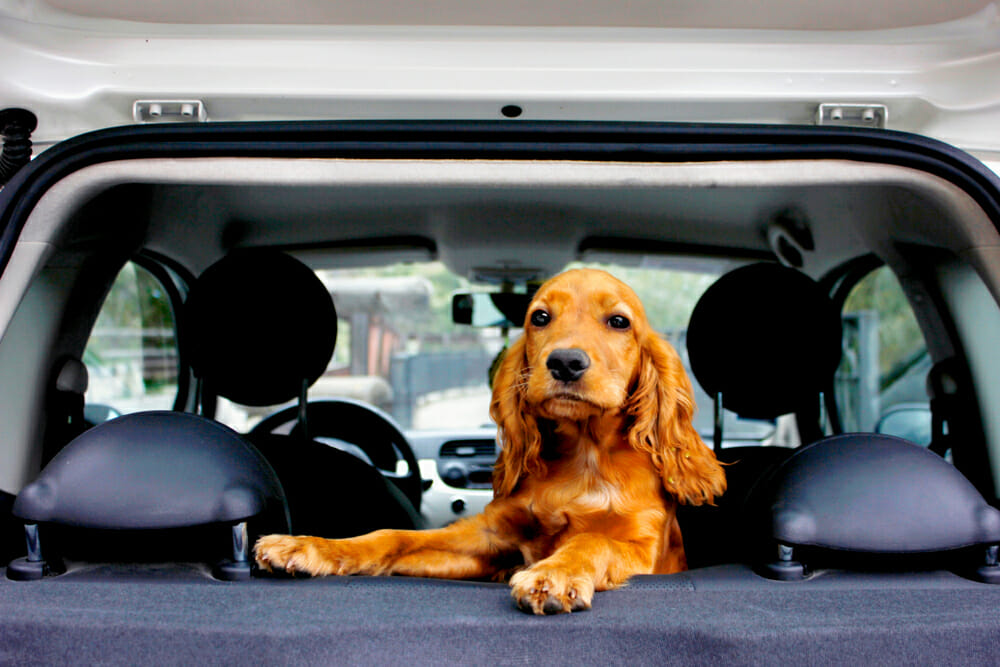The other day I was driving down the highway and looked over to see what I consider a fairly shocking sight; a car racing down the road at 80 kph and a little tiny fluffy dog sitting in the backseat window curled up on the ledge! My first thought was, “what if that driver has to make a sudden stop or make a sharp turn? That poor sweetie becomes an instant projectile missile, and straight through the windshield, they go!” I bet you any money, that dog-loving driver probably was completely unaware of the danger they were putting their sweet pup in.
That got me to thinking and how many people actually drive around with their dog loose in the backseat or worse the front seat! Not to mention folks who travel with their dog on their laps as they drive. It’s probably a whole lot more then we know about.
Most people nowadays would never think about driving down the street without buckling up themselves or their children. So why do we think our pets deserve any less protection when driving in a car? Did you know that when unrestrained, a 10 lbs dog will exert about 500 lbs of force in a collision at only 50 km/h? Make that an 80 lbs dog, and he will exert around 2,400 lbs of force at the same speed. Is there any way you could ever hold on to 80 lbs must less 2,400 lbs of weight, especially if you were holding on to that dog on your lap in a sudden stop? It would be literally impossible to do so. The force at impact would send your dog flying through the air in a split second before you could even register you had stopped – even worse if he is flying from your back seat through your windshield.
Now let’s go back to the dog in your lap. On impact, most cars have airbags that deploy in case of an impact. An animal who is hit with an airbag in the front seat is almost certainly going to suffer a fatal injury. Things just got serious with that mental picture is in your head. In addition, dogs and cats who are not secured present a distraction hazard to the driver. Scenarios such as frantic running back and forth in the back seat, licking or trying to jump on the driver can lead very easily to a distracted driver and in turn, potentially cause an accident. If involved in an accident an unsecured dog who is lucky to survive the accident, now can become lose and escape and either run off and get lost or put itself in further harm’s way again by running through traffic and now also possibly endangering other drivers as well. In a more serious crash where the driver is seriously injured, an unsecured dog who is hurt and frightened may also try to attack rescue personal trying to give medical care.
As you can see, there are so many reasons why you should make sure your pet is securely buckled in. A pet safety seat belt or a secure hard-sided well-ventilated kennel that is securely latched and properly tied down in either the back of an SUV or truck bed are the most secure ways to transport your pet.
There are many options and styles for seat belts and safety harnesses for dogs. The harness usually includes a loop at the back through which you can thread the strap from the car seat belt. The car seat belt is clicked into place like usual, and in doing so, the dog is secured in place. Dog seat-belts are made to work with nearly any type of car seat-belt. The best kind to look for has wide straps or padded chest pieces for more comfort. Ideally, the tether, which is the piece that attaches to the car’s seat belt, should be short so that the dog cannot be propelled too far forward in case of a sudden stop or accident.
Another option for smaller dogs is a dog booster seat. It allows them to see out the window while still providing some safety features. A dog car seat that clicks into your car’s existing seat-belt and also provides an additional harness for the dog is the ideal.
Lastly, the dog barrier — these are barriers that are installed between the front and back seats, or between the back seats and the cargo area of a vehicle. They help to prevent dogs from being thrown over into the front seat and also help to stop dogs from climbing into the front seat and distracting the driver. These should still be used in conjunction with a pet seat belt system as they would not prevent a dog from escaping a car in an accident if the car door was open.
With all these options easily available, why wouldn’t you want to make sure your best friend is safely transported, right? So, before you head out with your best doggo by your side this summer, whether it’s for a road trip across Nova Scotia or just for a quick spin down to the neighbourhood dog park, please think twice and make sure you have him or her securely buckled in. So, you can BOTH reach your destination happy and safe; in one piece.
If you have any questions about the best way to transport your furry friend, give us a call at 902.443.4345.
Written by: Barbara Duggan-Smith, Veterinary Assistant




